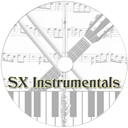Filter on ALL, SYNTH, DRUM, SAMPLER or MISC |
Total list currently 2405 items in 330 Brands |
Moog | Polymoog (203a) |
Description | The Polymoog is the descendant of an ambitious project by Moog Music to create a large ensemble system called the Constellation. It was to include two keyboard synthesizers, the polyphonic Apollo and monophonic Lyra, and the Taurus foot pedalboard synthesizer. Although the Constellation project never made it to production, the Taurus pedalboard was released on its own, while the "Apollo Polyphonic Synthesizer" went on to become the Polymoog. It is also noteworthy that the Apollo/Polymoog project did not directly involve Bob Moog and was instead mostly designed by Dave Luce at Moog Music. The Polymoog (model 203a) is a fully polyphonic preset-based synthesizer released in 1975. Its eight preset sounds consist of Strings, Piano, Organ, Harpsichord, Funk, Clavi, Vibes and Brass. There is also a Var (Variation) mode that allows any one of the preset sounds to be fully modified into unique and wild analog sounds using all of the available synthesis parameters on board. There’s a Moog ladder filter inside with modulation, keyboard tracking and lots of LFO modulation sources. The Polymoog features a full 71-key, velocity sensitive Pratt & Read weighted keyboard that can be split into three sections, each with independent volume sliders. The instrument does feature a touch sensitive keyboard continuing with Moog's "Touch Sense". There is a 3-band EQ, sample-and-hold, pitch controller ribbon and a full set of envelope controls. What you won’t find, however, is patch memory or MIDI control. It should be noted that the Polymoogs are not true poly synths in the traditional sense. They use a ‘divide-down’ circuitry arrangement similar to certain string synths, combo organs, etc. This allows them to be fully polyphonic across the entire range of the 71-note keyboard. Sadly, the Polymoog is rather unreliable and prone to breakdown; used specimens are often problematic when left unserviced. Unfortunately, their complexity makes them difficult to service and even more difficult to find a qualified technician. An optional Polypedal board (model 285a) allows for external control of the pitch, filter, and volume via two large black foot pedals. Sustain and trigger mode can be controlled by two smaller silver foot pedals, and external sync of the Polymoog can also be controlled. |
| Brand | Moog |
| Model | Polymoog (203a) |
| Device | Synth |
| Type | Keys |
| Engine Type | Analog |
| Engine | VCO |
| Voices (max) | 71 |
| Oscillators | 2 |
| LFO | 1 Saw Up, Saw Down, Square, Triangle |
| Noise | Y |
| Engine Detailed | 2 VCO’s, Pink Noise, Pulse, Saw Down, Saw Up, Square, Triangle, White Noise |
| Filter (VCF) | 24dB Slope (4-pole), High Pass, Low Pass, Resonance |
| Envelope (VCA) | 1 ADSR |
| FX | 3-band EQ |
| Memory | 1 User + 8 Presets: Strings, Piano, Organ, Harpsichord, Funk, Clavi, Vibes, and Brass. |
| Keys | 71 |
| Key type | Keys |
| Velocity | Y |
| Aftertouch | Channel |
| CV-gate | CV/GATE |
| Produced: | 1975 - 1978 |
| Legend: | Obvious | Y: Yes, N: No, N/A: Not Applicable | |
| VCO | Voltage Controlled Oscillator | DCO | Digital Controlled Oscillator |
| LFO | Low Frequency Oscillator | Sub | Sub Oscillator |
| VCF | Voltage Controlled Filter | VCA | Voltage Controlled Amplifier |
| Velocity | As with a piano, the harder you hit a key, the louder the sound, unlike most organs which always produce the same loudness no matter how hard you hit a key. | Aftertouch | Pressing a key after you activated it. Channel Aftertouch, no matter which key, it will send a Channel message. Poly Aftertouch, sends the pressure per key instead of the whole channel. |
| Values for OSC, LFO, Filter, Envelope are per voice unless stated otherwise. | |||
/Moog-Polymoog-1 prototype.jpg)
/Moog-Polymoog-4.jpg)
/Moog-Polymoog-6.jpg)
/pedal-285a.jpg)


